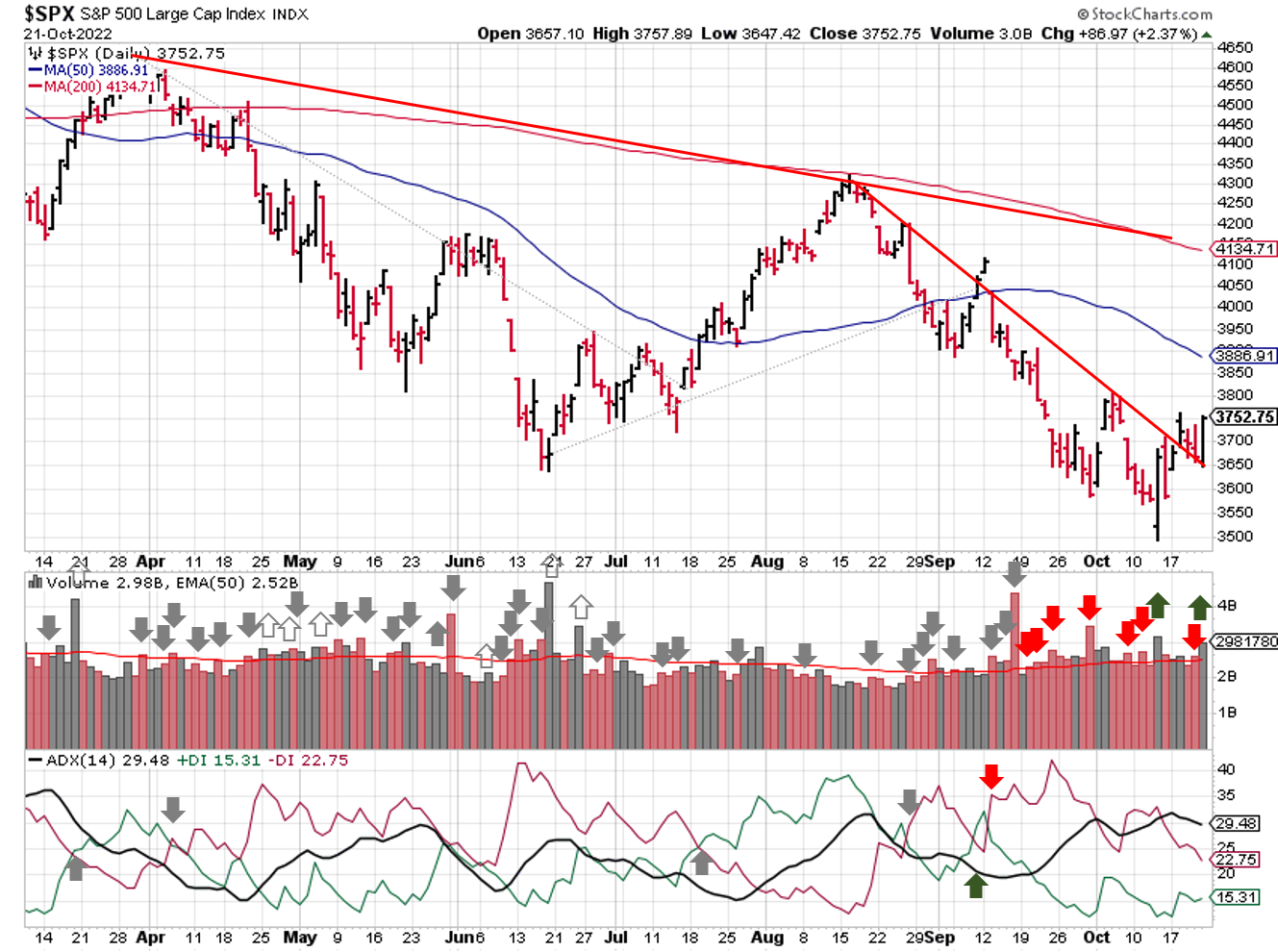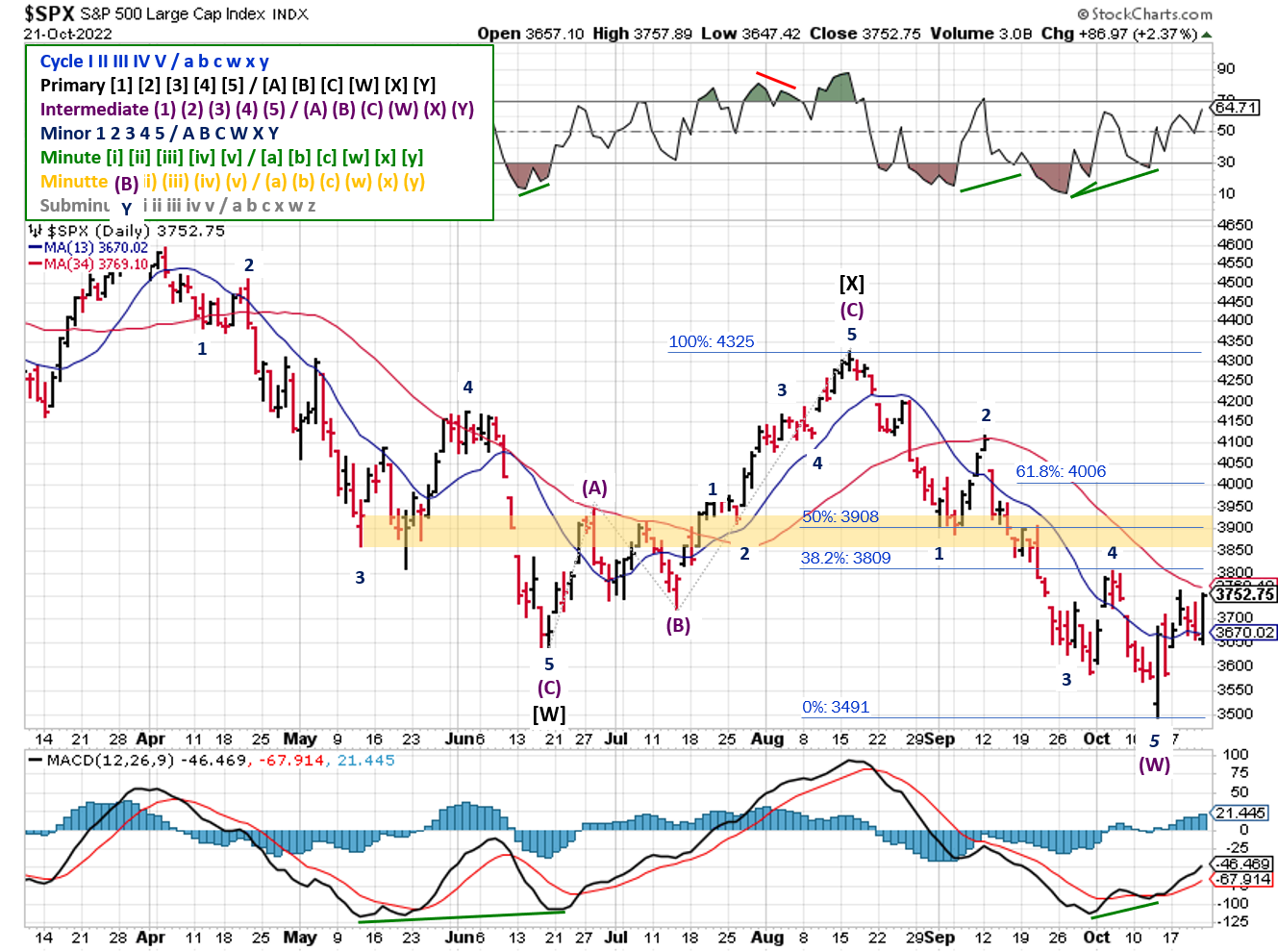Stock Market Outlook
For The Week Of October 23rd = Downtrend
INDICATORS
-
ADX Directional Indicators: Downtrend
Price & Volume Action: Uptrend
Elliott Wave Analysis: Downtrend
The S&P500 ($SPX) rose 4.7% last week, busting through a resistance trendline. The index sits 3.5% below the 50-day moving average and 9.3% below the 200-day moving average.
2022-10-23-SPX Trendline Analysis - Daily
The ADX signal continues in a downtrend, but price/volume flipped on Friday. The new uptrend signal comes from the follow-through day on Friday (>1.5% increase on higher than average trading volume).
That said, it's not an all clear, risk-on signal. The index still trades below the 50 day, and the higher volume follow-through was largely due to monthly option expiration. And the Friday session had A LOT of option volume, particularly in index options such as the SPX, meaning the session was more about trading options hedging activity, rather than strength from something like corporate earnings. Not to mention the fact that the VIX remains near 30.
2022-10-23- SPX Elliott Wave Analysis - Daily - Primary Y
Elliott Wave analysis still puts the SPX in the first wave of a 3-wave countertrend rally. For now, 3900 is still a plausible target, but the SPX has to make it past 3800 first. It's still possible that the prior downtrend isn't over and the SPX is working through a complex Minor 4 which would mean another wave down to complete Minor 5 (not pictured).
COMMENTARY
Rather than monthly option expiration, there was a lot of commentary on another cause for last week's rally. It's a bird, it's a plane...no, it's another Fed Pivot!
Okay, it's not a "pivot" this time; that would mean the Fed would cut rates. And it's not a "pause", or a stoppage in rate hikes, like the narrative that fueled the summer rally. This time, it's the hope that the target rate for ALL of the rate hikes (i.e. the "terminal" rate) will be lower than the market currently expects, so the December rate hike will only be 0.5%.

A few weeks ago, I mentioned that the Fed doesn't meet until November 1-2, so it was anyone's guess until that point in time. This "guess" came courtesy of Nick Timiraos of the Wall Street Journal, the Fed’s “unofficial” source when they want to send a signal to the markets. What did they want to communicate? A cut? A pause? A lower terminal rate?
No. Apparently the Fed wanted everyone to know that they'll discuss reducing the pace of rate hikes after raising rates 75 basis points in November. If that's the only good news for investors, that's not good. Believe it when you see it in the yield curve my friends.
Earnings season continues this week. So far, reports are not as bad as feared, but executives are expressing more concern about their outlooks for Q4 and 2023.
Investor sentiment is really bearish, and many stocks are oversold based on technical indicators. Those conditions set the stage for a tradable rally, but not a "buy and hold" type of bottom. Bear markets end when investors throw in the towel and stop trading all together. Judging from the trading volume on Friday, we're not there yet.
Best To Your Week!
P.S. If you find this research helpful, please tell a friend.
If you don't, tell an enemy.
Sources: Bloomberg, CNBC, Federal Reserve Bank of St. Louis, Hedgeye, U.S. Bureau of Economic Analysis, U.S. Bureau of Economic Analysis, WorldGovernmentBonds.com
Share this Post on:

How to Make Money in Stocks: A Winning System in Good Times and Bad.
It's one of my favorites.
I regularly share articles and other news of interest on:
Twitter (@investsafely)
Facebook (@InvestSafely)
LinkedIn (@Invest-Safely)
Instagram (@investsafely)
Invest Safely, LLC is an independent investment research and online financial media company. Use of Invest Safely, LLC and any other products available through invest-safely.com is subject to our Terms of Service and Privacy Policy. Not a recommendation to buy or sell any security.
Charts provided courtesy of stockcharts.com.
For historical Elliott Wave commentary and analysis, go to ELLIOTT WAVE lives on by Tony Caldaro. Current counts can be found at: Pretzel Logic, and 12345ABCDEWXYZ
Once a year, I review the market outlook signals as if they were a mechanical trading system, while pointing out issues and making adjustments. The goal is to give you to give you an example of how to analyze and continuously improve your own systems.
- 2015 Performance - Stock Market Outlook
- 2016 Performance - Stock Market Outlook
- 2017 Performance - Stock Market Outlook
- 2018 Performance - Stock Market Outlook
- 2019 Performance - Stock Market Outlook
- 2020 Performance - Stock Market Outlook
IMPORTANT DISCLOSURE INFORMATION
This material is for general communication and is provided for informational and/or educational purposes only. None of the content should be viewed as a suggestion that you take or refrain from taking any action nor as a recommendation for any specific investment product, strategy, or other such purpose. Certain information contained herein has been obtained from third-party sources believed to be reliable, but we cannot guarantee its accuracy or completeness.
To the extent that a reader has any questions regarding the applicability of any specific issue discussed above to his/her individual situation, he/she is encouraged to consult with the professional advisors of his/her choosing. Invest Safely, LLC is not a law firm, certified public accounting firm, or registered investment advisor and no portion of its content should be construed as legal, accounting, or investment advice.
The material is not to be construed as an offer or a recommendation to buy or sell a security nor is it to be construed as investment advice. Additionally, the material accessible through this website does not constitute a representation that the investments described herein are suitable or appropriate for any person.
Hypothetical Presentations:
Any referenced performance is “as calculated” using the referenced funds and has not been independently verified. This presentation does not discuss, directly or indirectly, the amount of the profits or losses, realized or unrealized, by any reader or contributor, from any specific funds or securities.
The author and/or any reader may have experienced materially different performance based upon various factors during the corresponding time periods. To the extent that any portion of the content reflects hypothetical results that were achieved by means of the retroactive application of a back-tested model, such results have inherent limitations, including:
Model results do not reflect the results of actual trading using assets, but were achieved by means of the retroactive application of the referenced models, certain aspects of which may have been designed with the benefit of hindsight
Back-tested performance may not reflect the impact that any material market or economic factors might have had on the use of a trading model if the model had been used during the period to actually manage assets
Actual investment results during the corresponding time periods may have been materially different from those portrayed in the model
Past performance may not be indicative of future results. Therefore, no one should assume that future performance will be profitable, or equal to any corresponding historical index.
The S&P 500 Composite Total Return Index (the "S&P") is a market capitalization-weighted index of 500 widely held stocks often used as a proxy for the stock market. Standard & Poor's chooses the member companies for the S&P based on market size, liquidity, and industry group representation. Included are the common stocks of industrial, financial, utility, and transportation companies. The S&P is not an index into which an investor can directly invest. The historical S&P performance results (and those of all other indices) are provided exclusively for comparison purposes only, so as to provide general comparative information to assist an individual in determining whether the performance of a specific portfolio or model meets, or continues to meet investment objective(s). The model and indices performance results do not reflect the impact of taxes.
Investing involves risk (even the “safe” kind)! Past performance does not guarantee or indicate future results. Different types of investments involve varying degrees of underlying risk. Therefore, do not assume that future performance of any specific investment or investment strategy be suitable for your portfolio or individual situation, will be profitable, equal any historical performance level(s), or prove successful (including the investments and/or investment strategies describe on this site).




